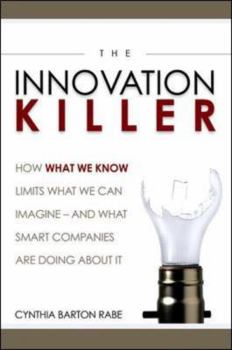The Innovation Killer: How What We Know Limits What We Can Imagine? and What Smart Companies Are Doing about It
Select Format
Select Condition 
Book Overview
"Knowledge is good," preaches the inscription under the statue of college founder Emil Faber in the film Animal House. But as valid as that declamation may be at a university, in the corporate world... This description may be from another edition of this product.
Format:Hardcover
Language:English
ISBN:0814408834
ISBN13:9780814408834
Release Date:July 2006
Publisher:AMACOM/American Management Association
Length:219 Pages
Weight:0.05 lbs.
Dimensions:0.9" x 6.3" x 9.0"
Age Range:17 years and up
Grade Range:Grade 12 and higher
Customer Reviews
5 ratings
Required Reading for all those fighting the Corporate Anti-bodies.
Published by Thriftbooks.com User , 16 years ago
Five stars. Two thumbs ups. And kudos to Ms. Rade for exposing organizational expert-think and for suggesting how it can be countered.
Promotes the concept of the 'zero-gravity thinker'
Published by Thriftbooks.com User , 17 years ago
Companies rely on established procedures and knowledge to streamline and drive business - but what happens to innovation in the process? Often it's squashed, taking with it flexibility and quick responses, risk taking, and acceptance of change. THE INNOVATION KILLER: HOW WHAT WE KNOW LIMITS WHAT WE CAN IMAGINE-AND WHAT SMART COMPANIES ARE DOING ABOUT IT promotes the concept of the 'zero-gravity thinker' not weighed down by group processes or expert opinions. Chapters provide case histories to illustrate the hidden costs of conducting business in manners too routine to encourage innovation. Diane C. Donovan California Bookwatch
How to overcome GroupThink and ExpertThink
Published by Thriftbooks.com User , 17 years ago
Rabe defines innovation as "an application of an idea that results in a valuable improvement." Her definition emphasizes that the ability to think innovatively should be a goal for every function in an organization - not just the new product or technology team. As she correctly observes, there is a process by which ideas become reality in most organizations. "First there is typically a challenge or opportunity to be addressed. Then someone comes up with an idea for addressing it. A stage of development or fine-tuning typically follows (this can be very short or, in the case of some product or technology innovations, very long) in order to apply the idea. The final result? An innovation." One of her most interesting - and most valuable - concepts is of what she calls "Zero-Gravity Thinkers." The title of her book refers to the most common barriers to innovation: practicioners of GroupThink ("the strongest force on earth") and ExpertThink ("GroupThink on steroids"). They establish and then vigorously defend all manner of "filters" to diminish if not "kill" any perceived threats to the status quo. Rabe concedes that Zero-Gravity Thinkers aren't a "magic solution" to such barriers because "there is no cure-all for a stuck-in-the mud organization." However, they are a high-value tool when recognizing and then responding effectively to the aforementioned "filters." Of special interest to many readers is what Rabe has to say about the leadership required when "going where no one has gone before." She does not limit her attention to leadership at the senior-management level. On the contrary, she convincingly explains why innovation leadership must be present at all levels and throughout all areas of an organization. Moreover, given the well-entrenched and highly-efficient "filters," the nature of the leadership required must itself be innovative. It must take into full account, for example, the perils of challenging traditional chains of authority and channels of communication. This is precisely what Jim O'Toole has in mind when discussing (in Leading Change) what he characterizes as "the ideology of comfort and the tyranny of custom." The power of GroupThink and ExpertThink must never be under-estimated. When necessary, effective leaders of innovation initiatives are courageous enough to ignore convention and act on their own intuition and rational arguments of those outside the given organization. Also, they are prudent but not risk-adverse. They never state or even imply that innovative thinking is acceptable only without the possibility of failure. What Rabe offers in this volume is a rigorous and thorough examination of who and what can "kill" innovation...and offers practical advice as to how to respond effectively and productively when opposed by them.
An "innovative" approach to innovation!
Published by Thriftbooks.com User , 17 years ago
This book provides an approach to enabling innovation that most organizations do not think of; and yet it is such a common problem to have "group think" around solving problems and trying be innovative. The book describes the value of the "zero gravity thinker", but also describes how it can be done. Great examples from real companies too!
A good book for helping companies innovate
Published by Thriftbooks.com User , 17 years ago
Ms. Rabe does a great articulating how companies can keep their competitive edge by creating an environment for continued innovation. There are good, real world examples combined with practical, doable tips for how to instill a stronger culture for innovation in any company.




